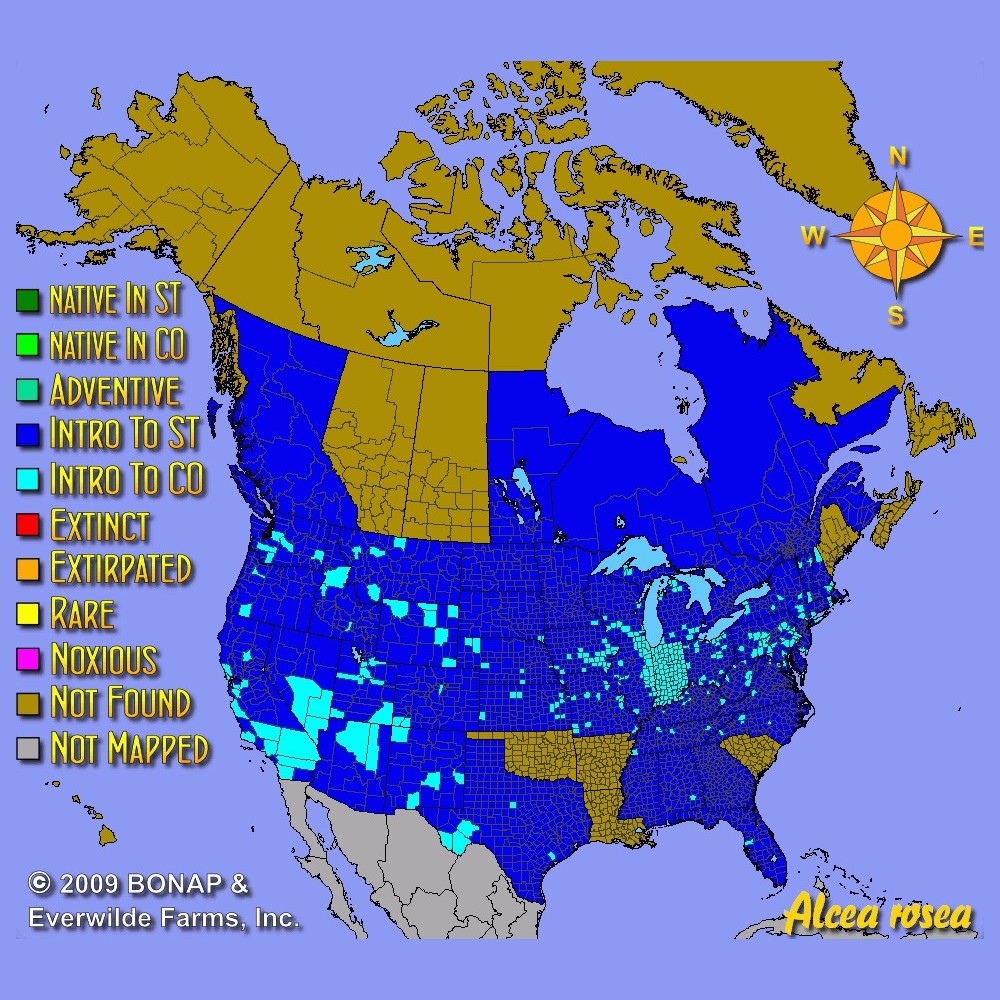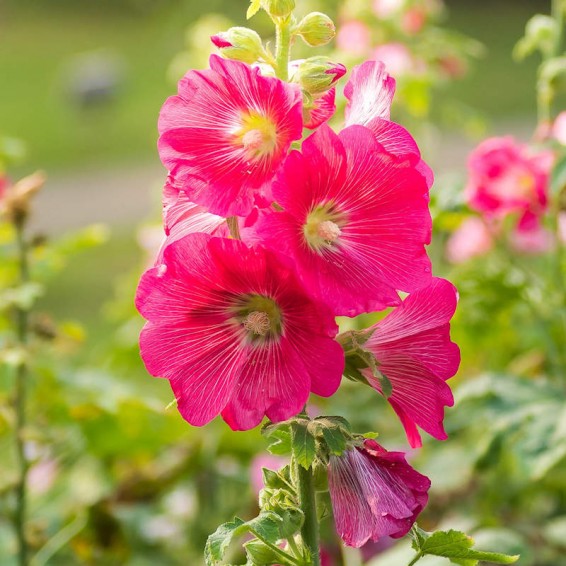Hollyhock Seeds
- HOW TO GROW
- FAST FACTS
- REVIEWS
HOW TO GROW
Sowing: For early spring growth, direct sow in August or September; hollyhock seeds can also be spring planted after the last spring frost. This plant grows best in full sun and rich soil, in a protected location. Plant the hollyhock seeds no more than 1/4" deep and do not allow the soil to dry out until the seeds germinate, which should occur in 14-21 days. Thin to 20-24" apart in rows 3' apart. Thinned seedlings can be transplanted. To start seed indoors, plant the seeds just below the surface of the soil; keep the soil moist and at a temperature of 70 degrees F until germination. After the last hard frost or when the plants grow big enough to handle safely, transplant them.
Growing: When the hollyhocks bloom, make sure the soil does not dry out; these plants do not tolerate dry soil. Water carefully to avoid getting the foliage wet, since this often leads to rust and other diseases. If leaves become infected by rust, remove them immediately. Watch young plants especially for slugs and snails. While some first year plants may bloom, full blooming will occur in the second year of growth. Pinching off the tips of the stalks for several weeks will cause fuller, shorter growth. Hollyhock self sows readily, making it practically perennial unless the spent blossoms are removed to prevent seed development. After the first frost of autumn, cut the stalks of the hollyhocks down to ground level and cover with a layer of mulch for protection; remove the mulch in the spring. Hollyhock also grows well as a container plant and attracts hummingbirds, butterflies, and bees.
Harvesting: Though hollyhocks reach their full potential when displayed in the garden, they can be used for cut flowers after a simple treatment. Because the stems secrete a sticky substance that causes them to become unable to draw in water, the stalks will immediately droop unless the ends are seared either with a flame or boiling water. Opinions differ on the best method of treatment, so experimentation may be necessary.
Seed Saving: After the hollyhock flowers have finished blooming, they will drop their petals and a fuzzy seed pod will form. When the outer covering of the pod begins to fold back to reveal the brown seeds, they have matured and are ready to be harvested. Remove the pods and spread them out to dry away from direct sunlight. Rub them lightly to separate the seed from the pods, and store the cleaned hollyhock seed in a cool, dry place.
FAST FACTS
Latin Name: Alcea rosea
Species Origin: China
Type: Garden Flowers
Life Cycle: Annual, Biennial
USDA Zones: 1, 2, 3, 4, 5, 6, 7, 8, 9, 10, 11, 12
US Regions: California, Mountain, Arid/Desert, Plains/Texas, Midwest, Northern, Northeast, Southeast
Seeds per Ounce: 2,200
Stratification: No Stratification
Germination Ease: No Stratification
Sunlight: Full Sun
Height: 64 Inches
Color: White, Pink, Red, Yellow
Bloom Season: Blooms Late Summer
Uses: Cut Flowers
My garden
Top seed vendor, always have great results!
This IS The Correct Name
In response to the review who was on their high horse, and gave a low rating out of spite:
This is the correct seed; referring to it as Hollyhock is correct. The only thing that should be considered when buying a plant is the scientific name. This plant IS Alcea rosea, also known as Hollyhock, in common language. There should be no disputations on the correct vs. incorrect common name, it all depends on the region you are in and what the locals refer to it as-this does not change the scientific name/identity of the plant. To give an example, Pinus ponderosa is known as Ponderosa pine where I'm from, but when I search for it online, it is known as the Yellow Western Pine. What a conundrum!!! Point is, a low rating should not have been given, because someone doesn't refer to it the same as another person does. Now, I'll get off my high horse.
Wrong Name
This plant is often referred to as "Althea or Alcea Rosea" although it is not a "Hollyhock - Althea". It is in the family "Malvina" and is var "Sylvestris". It casts seeds and is invasive. It is interesting that in my zone3 garden it continues to bloom sometimes into December. Note that the picture is of a "Hollyhock" and "Malvina Sylvestris has purple stripes on the petals. I have pictures for anyone interested.
DESCRIPTION

HOW TO GROW
Sowing: For early spring growth, direct sow in August or September; hollyhock seeds can also be spring planted after the last spring frost. This plant grows best in full sun and rich soil, in a protected location. Plant the hollyhock seeds no more than 1/4" deep and do not allow the soil to dry out until the seeds germinate, which should occur in 14-21 days. Thin to 20-24" apart in rows 3' apart. Thinned seedlings can be transplanted. To start seed indoors, plant the seeds just below the surface of the soil; keep the soil moist and at a temperature of 70 degrees F until germination. After the last hard frost or when the plants grow big enough to handle safely, transplant them.
Growing: When the hollyhocks bloom, make sure the soil does not dry out; these plants do not tolerate dry soil. Water carefully to avoid getting the foliage wet, since this often leads to rust and other diseases. If leaves become infected by rust, remove them immediately. Watch young plants especially for slugs and snails. While some first year plants may bloom, full blooming will occur in the second year of growth. Pinching off the tips of the stalks for several weeks will cause fuller, shorter growth. Hollyhock self sows readily, making it practically perennial unless the spent blossoms are removed to prevent seed development. After the first frost of autumn, cut the stalks of the hollyhocks down to ground level and cover with a layer of mulch for protection; remove the mulch in the spring. Hollyhock also grows well as a container plant and attracts hummingbirds, butterflies, and bees.
Harvesting: Though hollyhocks reach their full potential when displayed in the garden, they can be used for cut flowers after a simple treatment. Because the stems secrete a sticky substance that causes them to become unable to draw in water, the stalks will immediately droop unless the ends are seared either with a flame or boiling water. Opinions differ on the best method of treatment, so experimentation may be necessary.
Seed Saving: After the hollyhock flowers have finished blooming, they will drop their petals and a fuzzy seed pod will form. When the outer covering of the pod begins to fold back to reveal the brown seeds, they have matured and are ready to be harvested. Remove the pods and spread them out to dry away from direct sunlight. Rub them lightly to separate the seed from the pods, and store the cleaned hollyhock seed in a cool, dry place.
FAST FACTS
Latin Name: Alcea rosea
Species Origin: China
Type: Garden Flowers
Life Cycle: Annual, Biennial
USDA Zones: 1, 2, 3, 4, 5, 6, 7, 8, 9, 10, 11, 12
US Regions: California, Mountain, Arid/Desert, Plains/Texas, Midwest, Northern, Northeast, Southeast
Seeds per Ounce: 2,200
Stratification: No Stratification
Germination Ease: No Stratification
Sunlight: Full Sun
Height: 64 Inches
Color: White, Pink, Red, Yellow
Bloom Season: Blooms Late Summer
Uses: Cut Flowers
Reviews
Review
My garden
Top seed vendor, always have great results!
Review
This IS The Correct Name
In response to the review who was on their high horse, and gave a low rating out of spite:
This is the correct seed; referring to it as Hollyhock is correct. The only thing that should be considered when buying a plant is the scientific name. This plant IS Alcea rosea, also known as Hollyhock, in common language. There should be no disputations on the correct vs. incorrect common name, it all depends on the region you are in and what the locals refer to it as-this does not change the scientific name/identity of the plant. To give an example, Pinus ponderosa is known as Ponderosa pine where I'm from, but when I search for it online, it is known as the Yellow Western Pine. What a conundrum!!! Point is, a low rating should not have been given, because someone doesn't refer to it the same as another person does. Now, I'll get off my high horse.
Review
Wrong Name
This plant is often referred to as "Althea or Alcea Rosea" although it is not a "Hollyhock - Althea". It is in the family "Malvina" and is var "Sylvestris". It casts seeds and is invasive. It is interesting that in my zone3 garden it continues to bloom sometimes into December. Note that the picture is of a "Hollyhock" and "Malvina Sylvestris has purple stripes on the petals. I have pictures for anyone interested.






